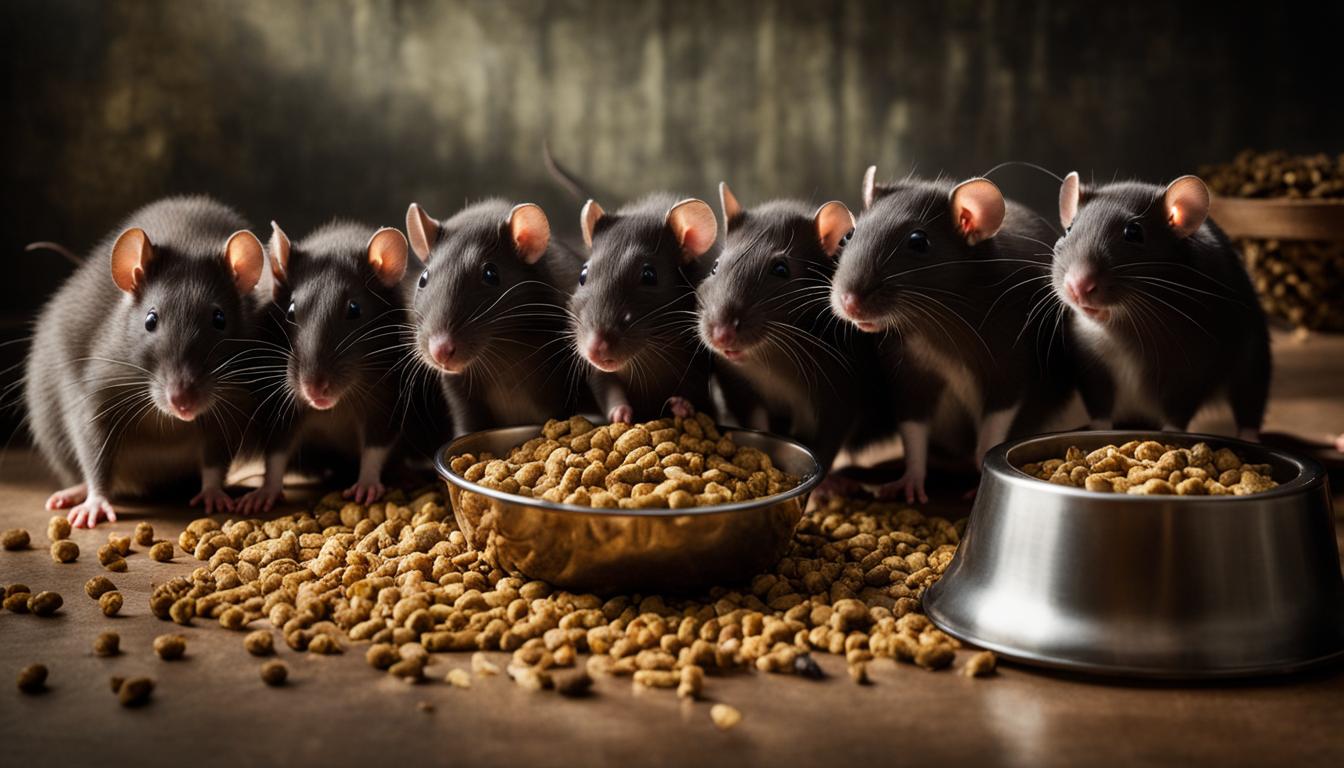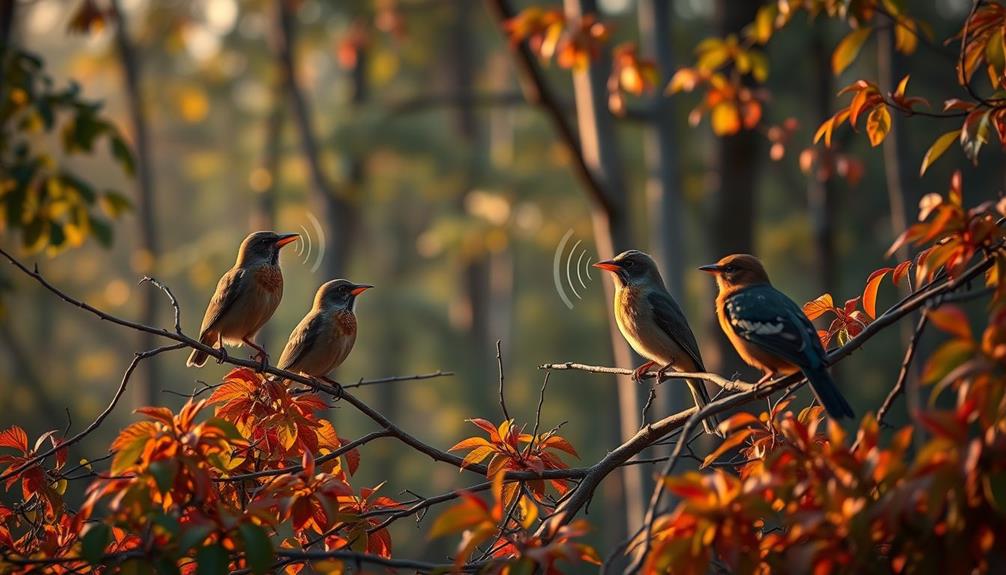The life cycle of a frog starts with frogspawn in spring, where eggs develop into tadpoles within weeks. As tadpoles grow, they feed on plant matter and undergo metamorphosis, transforming into froglets with legs and lungs. Adult frogs eventually emerge, flourishing on land and breeding to lay hundreds of eggs. Their survival faces challenges from habitat loss and pollution. Discovering ways to support these amazing creatures can make a real difference in their lives.
Key Takeaways
- Frog life begins with frogspawn, clusters of eggs laid in water, fertilized by male frogs.
- Tadpoles hatch from eggs in 1 to 3 weeks, initially feeding on their yolk.
- Metamorphosis transforms tadpoles into froglets over about 14 weeks, developing legs and lungs.
- Adult frogs emerge ready for land life, growing up to 13 cm and shifting to a carnivorous diet.
- Frogs face conservation challenges; creating wildlife ponds and reducing pesticides can help their populations thrive.
Frogspawn: The Beginning of Life
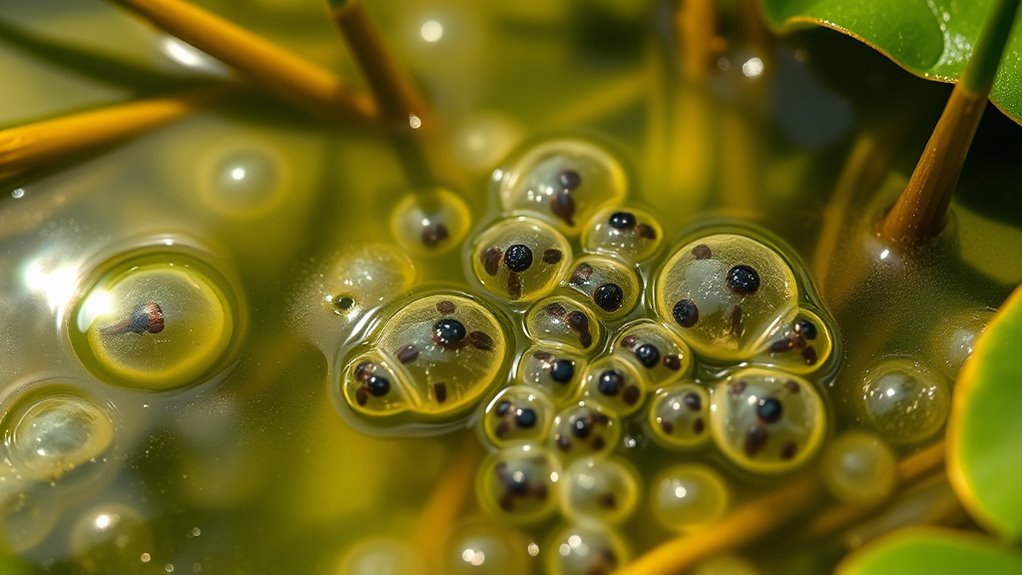
Frogspawn is the starting point of a frog's life cycle, marking the shift from aquatic eggs to fully developed frogs.
You'll notice frogspawn in early spring, as hundreds of tiny black eggs cluster together in ponds. Each egg is encased in a jelly-like substance that provides moisture and protection.
Fertilization happens when male frogs spray sperm over the eggs while clinging to females, a process that can take up to 24 hours. Once in the water, the eggs swell, beginning their development.
However, only about 1 in 50 eggs survives to adulthood due to predation and environmental factors. This is why choosing a safe environment in vegetation-rich ponds is essential for the frogspawn's success.
The Tadpole Stage: Growth and Transformation
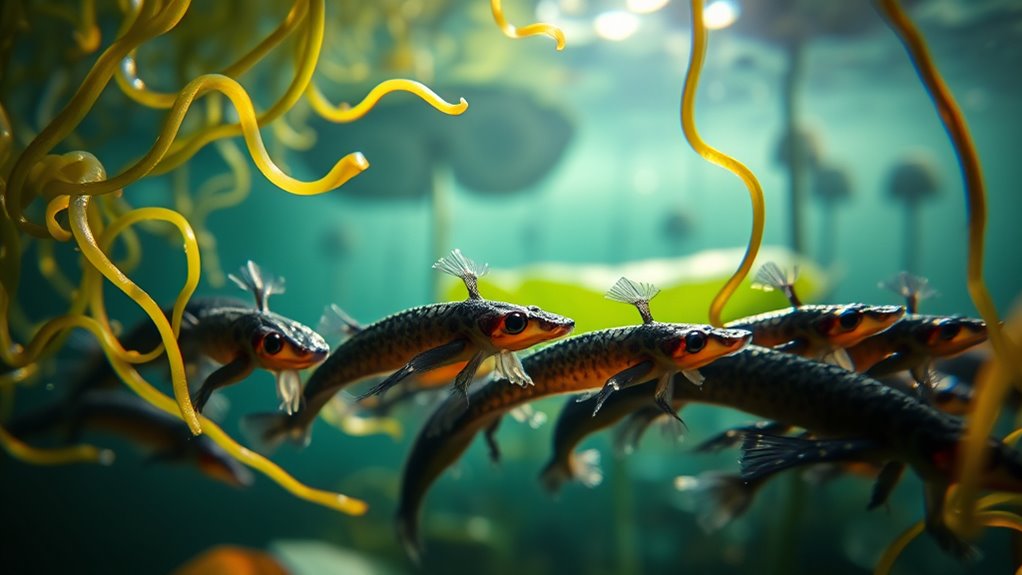
After 1 to 3 weeks, tiny tadpoles emerge from their eggs, marking an essential phase in a frog's life cycle. Initially, they feed on the yolk stored in their bodies before shifting to plant material. Tadpoles breathe using gills and have long tails that aid in swimming. As they grow, they can control their metamorphosis based on environmental conditions, delaying change if needed.
Here's a brief overview of their development:
| Stage | Description |
|---|---|
| Hatching | Tadpoles emerge and feed on yolk |
| Growth | Shift to plant material |
| Gills | Breathing underwater |
| Legs | Develop legs during metamorphosis |
| Young Frog | Final transformation occurs |
Metamorphosis: From Tadpole to Froglet
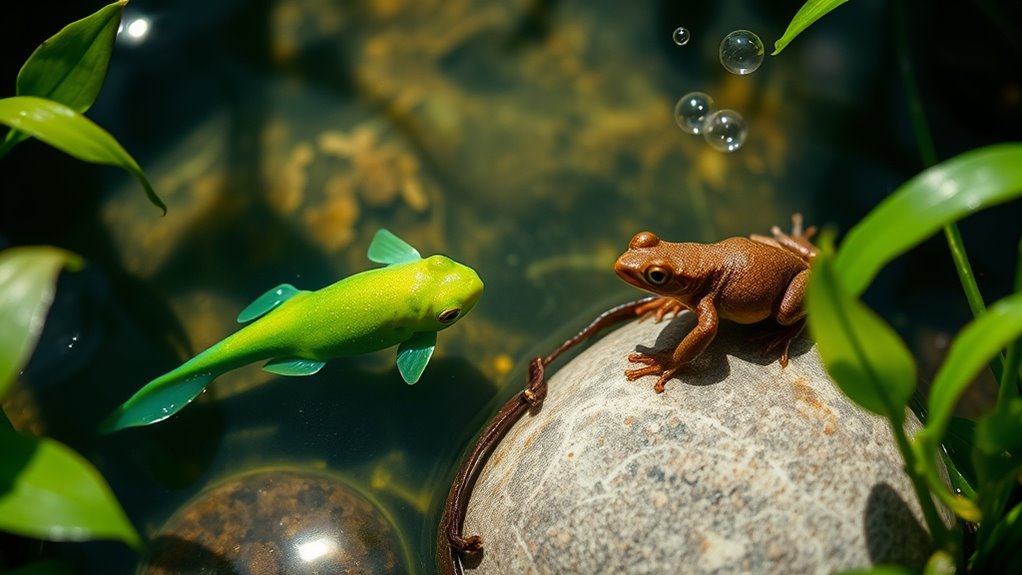
As tadpoles grow and develop, they begin a remarkable journey known as metamorphosis, transforming into froglets over roughly 14 weeks. This incredible transformation includes several key changes that prepare them for life on land:
- Hind legs develop first, allowing tadpoles to start moving more efficiently.
- Front legs appear next, completing their limb development as their tail begins to shrink.
- They shift from gills to lungs, enabling them to breathe air.
Throughout this cycle, environmental factors influence their growth, sometimes delaying metamorphosis to guarantee survival.
As tadpoles evolve into froglets, they showcase the incredible adaptability of nature, highlighting the importance of this transformation in their journey to becoming adult frogs.
The Adult Frog: Life on Land and Breeding
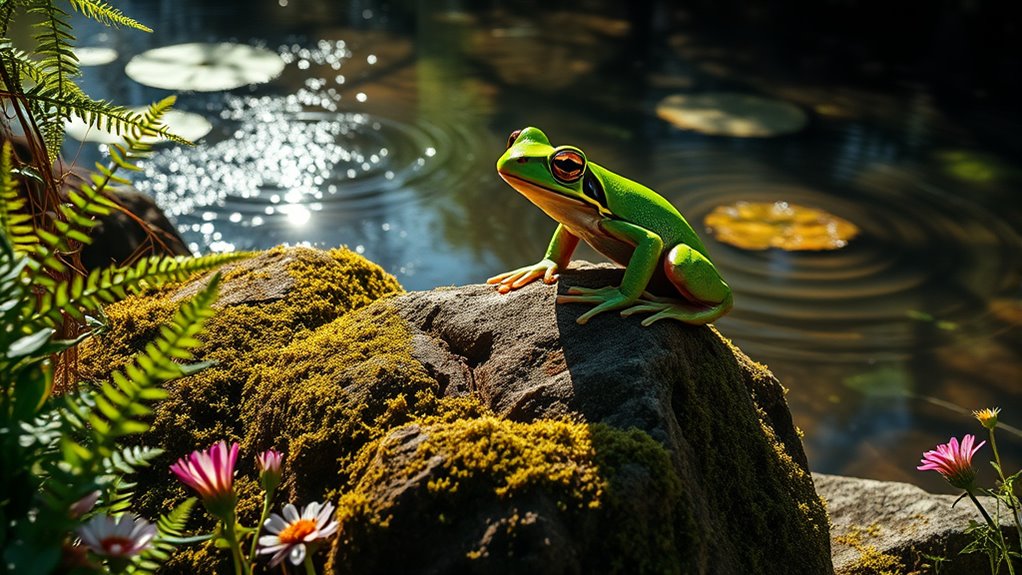
Once tadpoles complete their metamorphosis, they emerge as adult frogs, ready to embrace life on land.
These fascinating creatures can grow up to 13 cm and display various colors and patterns, aiding in camouflage within their terrestrial habitats. As adult frogs, they rely on lungs for breathing, often returning to water sources for hydration.
Starting around two to three years of age, they begin breeding, laying hundreds of eggs in water to guarantee the cycle continues.
Their diet shifts dramatically; now carnivorous, they feast on larger prey like flies, slugs, and snails. With specialized tongue muscles, they efficiently catch insects, a vital adaptation that enhances their survival and reproductive success in their new environment.
Conservation: How to Help Frogs Thrive
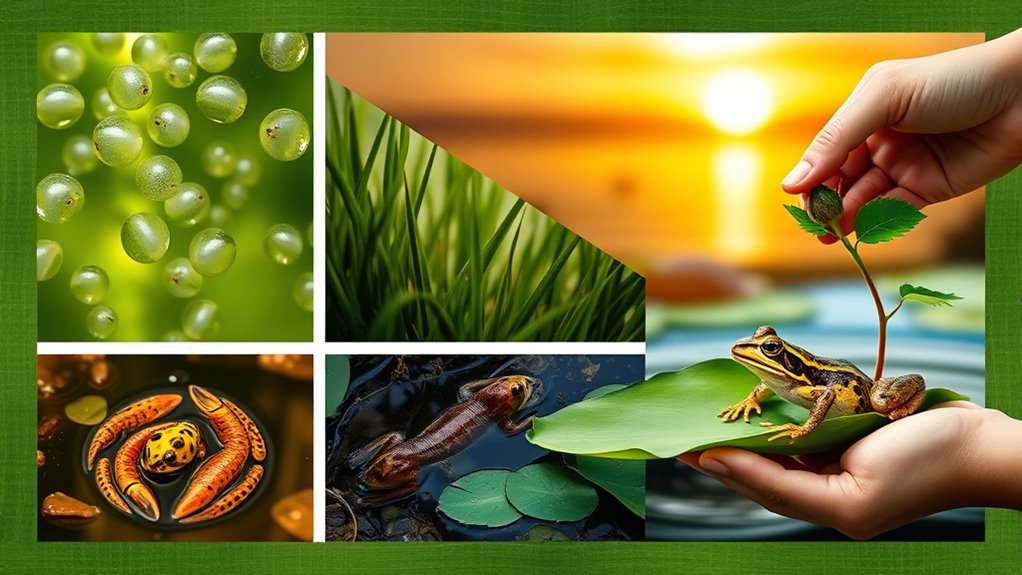
Although frogs play an essential role in maintaining healthy ecosystems, their populations face significant threats from habitat loss, pollution, and climate change.
You can help frogs thrive by taking action in your own backyard. Here are three key steps:
- Create a wildlife pond: Even a small container pond can provide crucial habitats for frogs and boost biodiversity.
- Plant native vegetation: Surround your pond with local plants to create a natural ecosystem that offers shelter and food for frog populations.
- Reduce pesticide use: Cut back on chemicals in your garden to protect frogs and their habitats.
Frequently Asked Questions
What Are the 5 Stages of the Frog Life Cycle?
You might be curious about the five stages of a frog's life cycle.
It begins with fertilized eggs laid in water, followed by the tadpole stage where they swim with gills and tails.
As they grow, they develop hind legs, then front legs, evolving into froglets.
Finally, they become adult frogs, capable of living both on land and in water.
This fascinating metamorphosis can take around 14 weeks from start to finish.
How Long Does It Take for a Tadpole to Turn Into a Frog?
Imagine a tiny warrior, starting its journey in a watery world.
A tadpole can take anywhere from a few months to several years to transform into a frog, depending on various factors like food and environment.
Typically, you'll see significant changes within 14 weeks as legs sprout and tails vanish.
If conditions aren't right, this little fighter might delay its metamorphosis, patiently waiting for the perfect moment to leap into adulthood.
What Is the Four-Step Life Cycle of a Frog?
You'll find the life cycle of a frog fascinating and straightforward. It starts with eggs laid in water, where they hatch into tadpoles.
These tadpoles, resembling fish, develop gills and tails. Next, they transform into young frogs, growing legs and adapting to land.
Finally, you'll see the adult frogs, fully matured and ready to breed, continuing the cycle. Each stage is essential for their growth and survival in their environment.
Do All Frogs Start as Tadpoles?
Imagine a quiet pond, the water shimmering under the sun. You might wonder, do all frogs start as tadpoles? Yes, they do!
Each frog begins its journey as an egg, waiting to hatch into a tiny, wriggling tadpole. These little creatures swim about, exploring their watery world with gills and tails.
As they grow, transformation begins, leading them from the depths of the pond to the land, where they'll eventually leap into their new lives.
Conclusion
As you watch a frog leap gracefully from lily pad to pond, remember the incredible journey it's taken. From the fragile frogspawn to the vibrant adult, each stage is a demonstration of resilience and transformation. By nurturing their habitats and protecting their waters, you can help guarantee that these remarkable creatures continue their dance in the wetlands. So, let's be stewards of nature, allowing the chorus of frogs to serenade us for generations to come.



